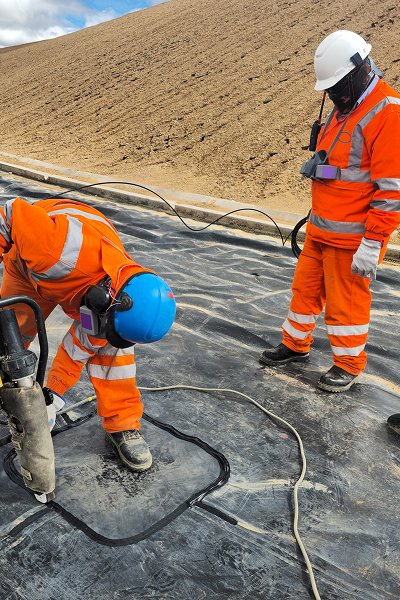Geotechnical materials include:
Geotextile: Non-woven and woven, primarily made from PP and PET.
Geomembrane: HDPE, LLDPE, PVC, etc., primarily used for waterproofing.
Geogrid: Primarily made from PP, PET, and HDPE, used for reinforcement.
Geocell: HDPE honeycomb structure, improving bearing capacity and stability.
Geosynthetic Clay Liner (GCL): A composite of bentonite and geotextile, offering exceptional environmental performance.
Core indicators of environmental performance
Environmentally friendly raw materials
Renewable raw material use: Some manufacturers are experimenting with incorporating recycled plastics (such as recycled bottle flakes) into PP and PET production.
Non-toxic and harmless ingredients: Comply with environmental standards such as GB/T 17643 and contain no heavy metals, plasticizers, or halogens.
Low-carbon-footprint raw materials: Select polymers with low energy consumption and low carbon emissions.
Environmental Contribution
Reduced natural resource extraction: Substituting natural materials such as sand, gravel, and clay reduces ecological damage.
Extended project life: Preventing premature road failure and embankment leakage, reducing maintenance and reconstruction.
Pollution Control: Geomembranes and GCLs prevent harmful substances from seeping into groundwater.
Recyclability and Reuse
Physical Recycling: HDPE geomembranes and PP geotextiles can be recycled into recycled pellets.
Secondary Use: Used geotextiles can be used as insulation layers in non-critical areas.
Exploration of Degradable Materials: Bio-based PLA and biodegradable polyester are under development.
Environmental protection project cases
Landfill HDPE geomembrane for landfill waterproofing
Environmental benefits: Prevents leachate from entering groundwater, meeting US EPA and EU standards.
Carbon reduction: Compared to traditional clay-based waterproofing, this method reduces material transportation by 70% and carbon emissions by 50%.


Civil Engineering Geocells
Environmental Benefits: Reduces hillside excavation and rock mining, protecting vegetation.
Ecological Benefits: The cells can be filled with planting soil, achieving both greening and stabilization benefits.


PET geogrid reinforcement for highway subgrade
Environmental benefits: Extends pavement life, reduces re-paving and resource waste.
Energy savings: Reduces asphalt usage by approximately 10%.


International Standards and Certifications for Environmental Performance
ISO 14001: Environmental management system standard established by the International Organization for Standardization (ISO).
CE Marking (EU): Safety and environmental compliance.
China Green Building Materials Label: A national green building materials evaluation system jointly promoted by China's Ministry of Industry and Information Technology, Ministry of Housing and Urban-Rural Development, and other agencies.
The environmental performance of geotechnical materials depends not only on their production methods but also on their substitution effects in engineering applications and their full lifecycle management. With the increasing demand for green and low-carbon development, the geotechnical materials industry will upgrade from "environmentally qualified" to "environmentally prioritized" and pursue sustainable development.


